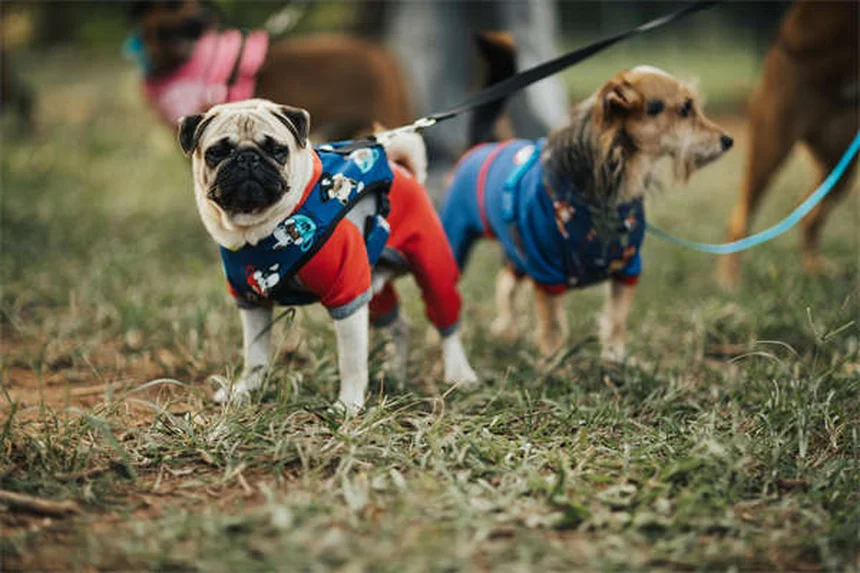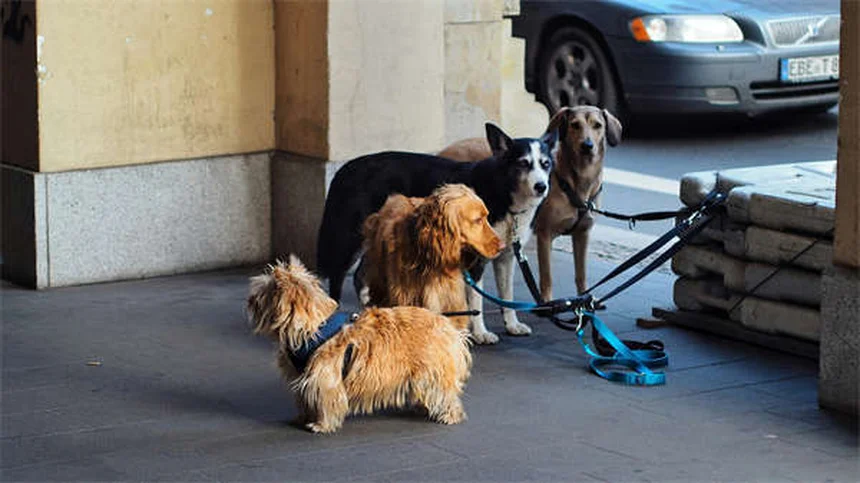How can you protect your dog during thunderstorms? The answer is simple: with proper preparation and these 5 essential safety tips. As a pet owner myself, I know how terrifying storms can be for our furry friends. Nearly 1 in 3 dogs experience storm anxiety, which can lead to destructive behavior or even dangerous escape attempts. But don't worry - we've got you covered with practical, vet-approved strategies that actually work. From creating a safe space to choosing the right calming products, you'll learn exactly what to do before, during, and after storms to keep your pup safe and comfortable. Let's dive in!
E.g. :Clicker Training for Cats: 5 Easy Steps to Train Your Feline
Advertisement
- 1、Keeping Furry Friends Safe During Thunderstorm Season
- 2、Pre-Storm Preparation: Your Game Plan
- 3、Storm Survival Strategies
- 4、When You're Caught Outside
- 5、Calming Products That Actually Work
- 6、Final Thoughts on Storm Safety
- 7、Understanding Pet Anxiety Beyond Storms
- 8、Building Confidence in Nervous Pets
- 9、Emergency Preparedness for Pet Owners
- 10、Alternative Therapies Worth Trying
- 11、Making Your Home a Safe Haven
- 12、FAQs
Keeping Furry Friends Safe During Thunderstorm Season
Hey there pet parents! Let's talk about something that makes many of us nervous - thunderstorms and our four-legged family members. Did you know that nearly 30% of dogs show signs of storm anxiety? That's a whole lot of scared pups out there!
Why Storms Scare Our Pets
Imagine you're a dog or cat. Suddenly, the sky starts booming, flashing, and pouring rain. Pretty terrifying, right? Their hearing is way more sensitive than ours, so that thunder sounds like the end of the world to them!
Here's the thing - when pets panic, they might:
- Chew through doors or windows
- Dig at carpets
- Try to escape outside
Pre-Storm Preparation: Your Game Plan
Indoor Safety First
No matter how much your outdoor cat gives you the stink eye, bring them inside when storms are coming. Even covered porches or dog houses aren't safe during severe weather.
I learned this the hard way when my neighbor's cat got spooked and hid under a car - right before lightning struck a nearby tree. The static electricity traveled through the ground and gave poor Whiskers quite a shock! Now we make sure all pets are inside well before storms hit.
 Photos provided by pixabay
Photos provided by pixabay
Ditch the Metal Accessories
Here's a quick safety tip: Remove any metal collars or harnesses before storms. Why? Because:
| With Metal Collar | Without Collar |
|---|---|
| Risk of electrical conduction | No conduction risk |
| Could get caught on furniture | Freedom to move safely |
Funny story - my dog Buddy once got his metal tags stuck in the heating vent during a storm. We spent 20 minutes trying to free him while he howled like we were torturing him! Now we take everything off when the weather turns bad.
Storm Survival Strategies
Creating a Cozy Safe Space
Want to know what works wonders? A storm bunker for your pet! Here's how to make one:
For dogs:
- Use their crate (if they're crate trained)
- Cover it with blankets to muffle sound
- Add favorite toys and treats
For cats:
- Set up a cardboard box with soft bedding
- Place it in a quiet corner
- Include a piece of your worn clothing
Did you know that playing soft classical music can actually help calm pets during storms? It's true! The steady rhythms help mask the scary thunder noises.
Tech to the Rescue
Here's a question you might be wondering: "What if my pet runs away during the storm?" Great question! That's exactly why microchipping is so important.
Microchips are tiny - about the size of a grain of rice - but they can make all the difference. When shelters scan lost pets, they can immediately access your contact info. Pets with microchips are 20 times more likely to be reunited with their families!
When You're Caught Outside
 Photos provided by pixabay
Photos provided by pixabay
Ditch the Metal Accessories
Picture this: You're walking Fido when suddenly - BOOM! - thunder cracks overhead. What now?
First, don't panic. Your pet will pick up on your energy. Look for shelter immediately, but avoid:
- Tall trees
- Metal structures
- Open fields
If you can't find shelter, crouch low (but don't lie down) and wait it out. And here's a pro tip: Always check the weather forecast before long walks during storm season!
Post-Storm Safety Check
Another question pet owners often ask: "How soon after the storm can we go back outside?" Here's the deal - wait at least 30 minutes after the last thunder or lightning.
Lightning can strike up to 10 miles from the actual storm clouds. I once saw lightning hit a clear blue sky area while storm clouds were in the distance - nature's sneaky like that sometimes!
Calming Products That Actually Work
Anxiety Relief Options
There's a whole market of pet calming products, but which ones really work? Based on my experience and vet recommendations:
For dogs:
- ThunderShirts (like a comforting hug)
- Calming treats with melatonin
- White noise machines
For cats:
- Feliway diffusers
- Catnip (for some cats)
- Heated beds
Remember, every pet is different. What works for my anxious Labrador might not work for your laid-back tabby. It's all about finding the right combination for your furry friend.
Final Thoughts on Storm Safety
Thunderstorms don't have to be terrifying for your pets. With some preparation and the right tools, you can help them weather the storm safely. The key is to:
- Plan ahead
- Create safe spaces
- Stay calm yourself
And most importantly - give lots of cuddles (if your pet likes them) when the storm passes. After all, they trust us to keep them safe, and we wouldn't want to let them down!
Understanding Pet Anxiety Beyond Storms
 Photos provided by pixabay
Photos provided by pixabay
Ditch the Metal Accessories
While thunderstorms are a major stressor, they're not the only thing that can send our pets into panic mode. Fireworks rank even higher on the scary scale for many animals - those sudden, unpredictable explosions make Fourth of July the busiest day for lost pet reports.
Vacuum cleaners, hair dryers, and even doorbells can trigger anxiety in sensitive pets. My cousin's poodle starts shaking whenever someone rings the doorbell - we've started calling it "the demon chime" because of his dramatic reaction. The key is recognizing these triggers early and creating positive associations through training.
The Science Behind Pet Fears
Ever wonder "Why do some pets freak out while others sleep through storms?" It's not just personality - genetics play a huge role. Studies show that herding breeds like Collies and Shepherds tend to be more noise-sensitive, while Labrador Retrievers often handle loud noises better.
Here's a fascinating fact: Dogs can hear frequencies up to 65,000 Hz (we top out at 20,000 Hz). That means when your microwave beeps, your dog hears something closer to a car alarm! No wonder sudden noises upset them so much.
Building Confidence in Nervous Pets
Desensitization Techniques That Work
You can actually help your pet become less afraid over time. Start by playing storm sounds at very low volume while giving treats - gradually increase the volume over weeks. This technique works for about 75% of dogs when done consistently.
For cats, try pairing scary sounds with their favorite activities. Play thunder recordings softly during mealtime or while playing with a feather toy. My friend's cat now associates storm sounds with tuna time - talk about turning lemons into lemonade!
The Power of Positive Reinforcement
Never punish fearful behavior - it only makes things worse. Instead, reward calm behavior with:
| What to Reward | Great Rewards |
|---|---|
| Sitting quietly during noise | Small training treats |
| Choosing to go to safe space | Favorite chew toy |
| Checking in with you when scared | Verbal praise and pets |
Remember that scaredy-cat I mentioned earlier? We trained him to fetch his "security blanket" when nervous - now he proudly carries it around during storms like a little knight with his cape!
Emergency Preparedness for Pet Owners
Creating a Pet Go-Bag
Natural disasters can strike anytime. Every pet household needs an emergency kit with:
- 3 days' food and water
- Medications
- Vaccination records
- Recent photos
- First aid supplies
Store it somewhere easily accessible - you don't want to be digging through closets during an evacuation. I keep mine right by the door with my human emergency supplies. Pro tip: Rotate the food every few months so it stays fresh.
Identifying Pet-Friendly Shelters
Here's something most people don't think about until it's too late: "Where can I take my pets if we need to evacuate?" Many emergency shelters don't accept animals, so research pet-friendly options in advance.
Call local hotels to ask about pet policies during emergencies. Some vet offices and boarding facilities offer temporary storm shelter too. I've got a list of five safe places within 20 miles - peace of mind is priceless when the weather turns bad.
Alternative Therapies Worth Trying
Natural Calming Solutions
Beyond ThunderShirts and medications, there are some surprisingly effective natural options. Adaptil collars release comforting pheromones that mimic a mother dog's natural calming scent. For cats, try silvervine - it's like supercharged catnip that can distract them from storm stress.
Massage therapy works wonders too! Gentle ear rubs and shoulder massages can lower a pet's heart rate during stressful events. My dog now demands his "spa treatment" whenever he hears distant thunder - he's got me trained well!
When to Consider Professional Help
If your pet's anxiety causes self-injury or severe destruction, it's time to call in the experts. Veterinary behaviorists can create customized treatment plans that might include:
For extreme cases:
- Prescription anti-anxiety meds
- Behavior modification programs
- Professional desensitization training
Don't feel bad if your pet needs extra help - some anxieties are just too big to handle alone. It's like needing glasses for bad vision; there's no shame in using tools that improve quality of life!
Making Your Home a Safe Haven
Soundproofing Strategies
Simple home modifications can dramatically reduce storm stress. Try these budget-friendly ideas:
- Weatherstripping around doors/windows
- Heavy curtains in favorite rooms
- White noise machines near resting spots
We installed a $20 window insulator kit and it cut the storm noise in half for our bedroom - where our dog prefers to ride out bad weather. Now he barely notices anything until the thunder gets really close!
The Comfort of Routine
Pets thrive on predictability. During storm season, stick to regular feeding times, walks, and play sessions. This sense of normalcy helps counteract the chaos of bad weather.
I always do a special training session with my dog when storms are predicted - it keeps his mind occupied and reinforces that good things happen even when the sky is angry. Bonus: He's learned some impressive tricks thanks to storm days!
E.g. :Thunderstorm and Lightning Safety for Pets | PetMD
FAQs
Q: What's the most important thing to do for my dog before a thunderstorm?
A: The absolute first thing you should do is bring your dog inside well before the storm hits. Even if your dog normally loves being outside, thunderstorms are different. I learned this lesson when my neighbor's golden retriever dug under their fence during a storm and was missing for two days! Indoor spaces are safer because they protect against lightning strikes, flying debris, and the risk of your dog running away in panic. Create a cozy den-like area with their favorite blanket and toys to help them feel secure. And remember - even if your dog has an outdoor dog house, it's not storm-proof!
Q: Should I keep my dog's collar on during a thunderstorm?
A: Actually, you should remove any metal collars or tags when storms are approaching. Here's why: metal conducts electricity, which could be dangerous if lightning strikes nearby. Plus, anxious dogs often try to squeeze into tight spaces, and collars can get caught on furniture or vents (trust me, I've had to free my dog from some pretty creative predicaments!). Instead, make sure your dog is microchipped - it's a safe, permanent form of identification that won't pose any risk during storms.
Q: What are the best products to calm my dog during storms?
A: After trying nearly every product on the market with my anxious Labrador, I can tell you that ThunderShirts work wonders for many dogs. These snug-fitting vests apply gentle pressure that helps reduce anxiety - think of it like a comforting hug. Other options include calming treats with natural ingredients like melatonin, white noise machines to mask thunder sounds, and pheromone diffusers. But here's the thing: every dog is different, so you might need to experiment to find what works best for your pup. Your vet can recommend safe, effective options too!
Q: What should I do if I get caught outside with my dog during a storm?
A: First, don't panic - your dog will pick up on your energy. Look for solid shelter immediately, like a building or car. Avoid trees, metal structures, and open fields. If you can't find shelter, crouch low (but don't lie down) in a ditch or depressed area. Stay away from water and anything metal. Pro tip: Always check the weather forecast before long walks during storm season, and consider shorter routes when storms are possible. I keep a collapsible water bowl and small towel in my walking bag just in case we get caught in bad weather.
Q: How soon after a storm is it safe to let my dog outside?
A: The general rule is to wait at least 30 minutes after the last thunder or lightning before going outside. Here's why: lightning can strike up to 10 miles from the actual storm clouds! I once saw lightning hit a completely clear area while storm clouds were still visible in the distance. After the wait period, do a quick safety check of your yard for downed branches, standing water, or other hazards before letting your dog out. And give them lots of praise and treats for being so brave during the storm!

